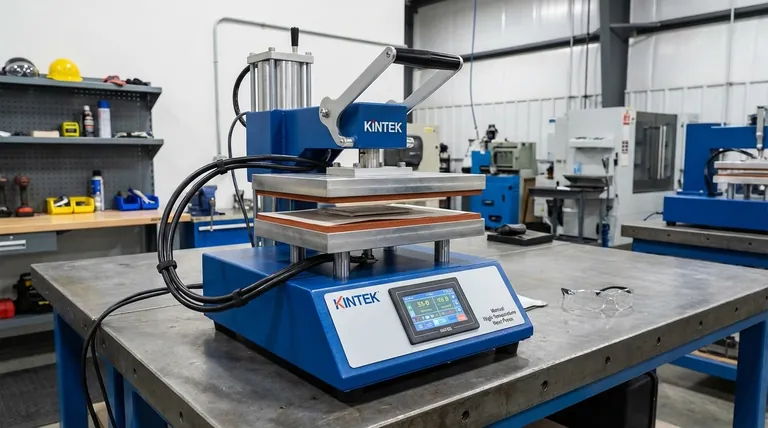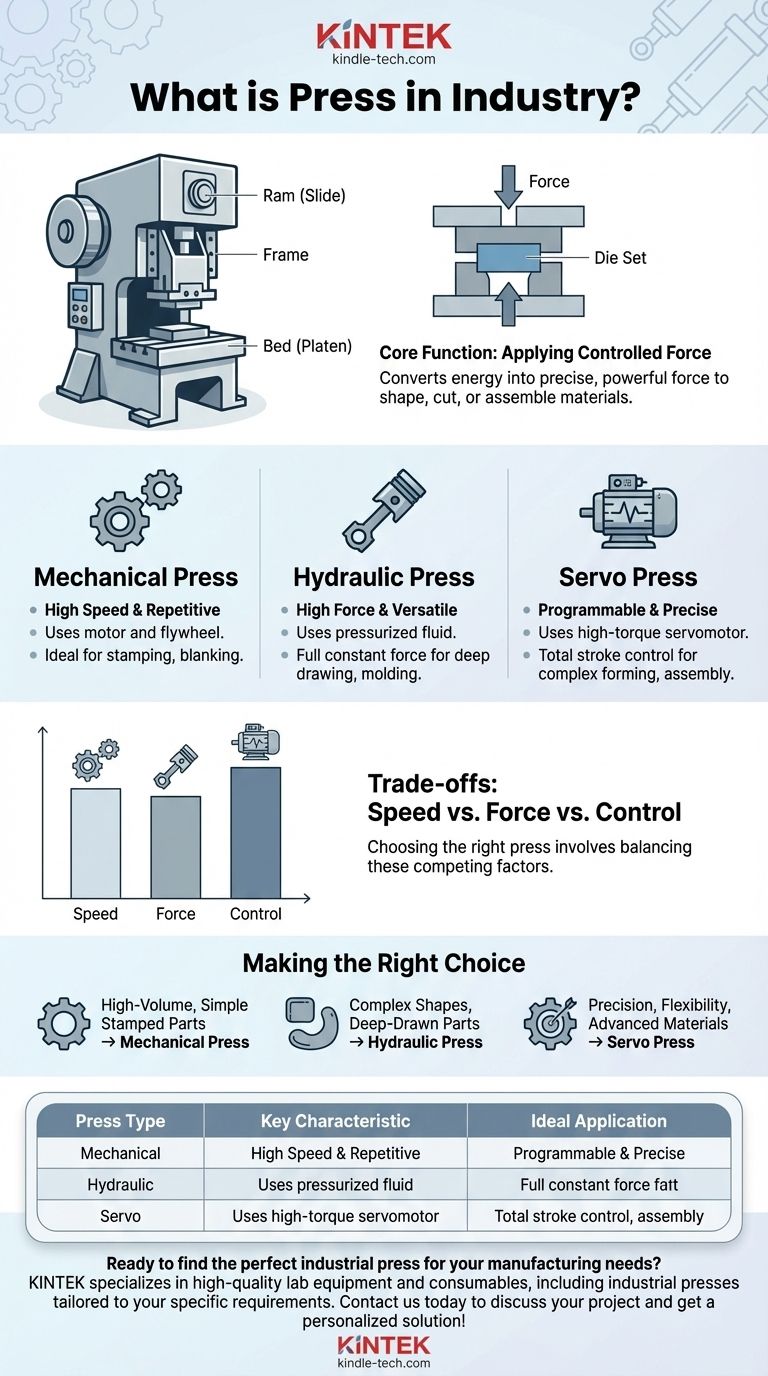In industry, a press is a machine tool that changes the shape of a workpiece by applying controlled force. It is one of the most fundamental pieces of equipment in manufacturing, used to form, cut, or assemble materials ranging from sheet metal and plastics to composites and powdered metal. These machines are the workhorses behind countless everyday items, from car doors and kitchen sinks to coins and electronic components.
At its core, an industrial press is a device for converting energy into precise, powerful force. The critical decision is not if you need a press, but which type—mechanical, hydraulic, or servo—best aligns with your specific need for speed, power, or programmability.

The Core Function: Applying Controlled Force
Every press, regardless of its size or power source, operates on the same basic principle: a stationary bed holds the workpiece, and a moving ram or slide descends to exert force upon it.
The Basic Components
A press consists of three main parts:
- The Frame: The rigid structure that houses all components and resists the forces generated during operation.
- The Bed (or Platen): The stationary, flat surface where the bottom half of the tool (die) is mounted and the workpiece rests.
- The Ram (or Slide): The moving component that holds the upper half of the die and travels toward the bed to perform the work.
Think of it as an industrial-scale garlic press. The handles and body are the frame, the bottom cup is the bed, and the plunger you push is the ram.
Dies: The Tools That Do the Work
It is crucial to understand that the press itself only provides the force. The actual shaping, cutting, or forming is done by a die set—the custom tooling mounted to the ram and the bed. The precision and design of the die determine the final shape and quality of the part.
The Primary Types of Industrial Presses
The key differentiator between presses is how they generate force. This determines their speed, capabilities, and ideal applications.
The Mechanical Press: Built for Speed and Repetition
Mechanical presses use a motor to spin a heavy flywheel, storing rotational energy. When activated, a clutch connects the flywheel to a crankshaft, which converts the rotation into the vertical motion of the ram.
These presses are known for their high speed and consistent stroke length, making them ideal for high-volume production like blanking (punching out flat shapes) and stamping.
The Hydraulic Press: Designed for Power and Versatility
Hydraulic presses use a large piston and cylinder, driven by high-pressure fluid, to move the ram. This design operates on Pascal's Principle, allowing it to generate enormous force from a relatively simple system.
The defining feature is its ability to deliver full, constant force throughout the entire stroke. This makes it superior for deep-drawing operations (like forming a sink basin), molding, and applications requiring sustained pressure.
The Servo Press: The Evolution of Precision Control
Also known as an electric press, the servo press uses a high-torque servomotor directly connected to the drive train. This eliminates the flywheel and clutch of a mechanical press and the fluid systems of a hydraulic one.
The result is total programmability over the ram's movement. Operators can control the position, velocity, and force at any point in the stroke. This unmatched flexibility is perfect for complex forming, working with high-strength steels, and precision assembly.
Understanding the Trade-offs: Speed vs. Force vs. Control
Choosing the right press involves balancing three competing factors. No single type is universally "best."
Mechanical: High Speed, Limited Control
The advantage is rapid cycle times, measured in strokes per minute. The disadvantage is that maximum force is only available at the very bottom of the stroke, and the stroke length is fixed. They are powerful but not particularly flexible.
Hydraulic: Maximum Force, Slower Speed
The key benefit is having full tonnage available at any point in the ram's travel. However, cycle times are generally slower than mechanical presses due to the time it takes to move the hydraulic fluid. They are powerful and versatile but not the fastest option.
Servo: Total Control, Higher Cost
A servo press offers the speed of a mechanical press with the control of a hydraulic one. The ability to program the stroke profile is a significant advantage for complex tasks. This performance, however, comes with a higher initial investment and increased complexity.
Making the Right Choice for the Job
Your application dictates the ideal technology. The goal is to match the machine's core strength to your manufacturing priority.
- If your primary focus is high-volume production of simple stamped parts: A mechanical press offers the best combination of speed and cost-efficiency.
- If your primary focus is forming complex shapes or deep-drawn parts: A hydraulic press provides the consistent force and dwell time needed for these demanding applications.
- If your primary focus is precision, flexibility, and working with advanced materials: A servo press is the superior choice, providing unparalleled control over the entire forming process.
Understanding these fundamental differences empowers you to select not just a machine, but the right manufacturing process for your specific goal.
Summary Table:
| Press Type | Key Characteristic | Ideal Application |
|---|---|---|
| Mechanical | High Speed, Repetitive | Stamping, Blanking |
| Hydraulic | High Force, Versatile | Deep Drawing, Molding |
| Servo | Programmable, Precise | Complex Forming, Assembly |
Ready to find the perfect industrial press for your manufacturing needs? KINTEK specializes in providing high-quality lab equipment and consumables, including industrial presses tailored to your specific requirements. Whether you need the speed of a mechanical press, the power of a hydraulic press, or the precision of a servo press, our experts can help you select the right machine to enhance your production efficiency and product quality. Contact us today to discuss your project and get a personalized solution!
Visual Guide

Related Products
- Manual High Temperature Heated Hydraulic Press Machine with Heated Plates for Lab
- Manual Heated Hydraulic Press Machine with Heated Plates for Laboratory Hot Press
- Automatic Heated Hydraulic Press Machine with Heated Plates for Laboratory Hot Press 25T 30T 50T
- Heated Hydraulic Press Machine with Integrated Manual Heated Plates for Lab Use
- Touchscreen Automatic Vacuum Heat Press
People Also Ask
- How much force can a hydraulic press exert? Understanding its immense power and design limits.
- Why do you need to follow the safety procedure in using hydraulic tools? Prevent Catastrophic Failure and Injury
- Does a hydraulic press have heat? How Heated Platens Unlock Advanced Molding and Curing
- How is the pressure and temperature process used to make a synthetic diamond? Replicate Earth's Diamond Formation in a Lab
- How much psi can a hydraulic press make? From 2,000 PSI to over 50,000 PSI Explained



















